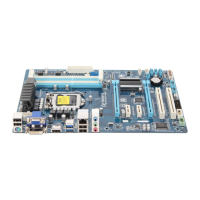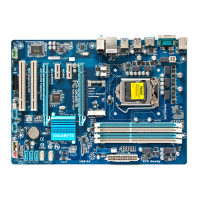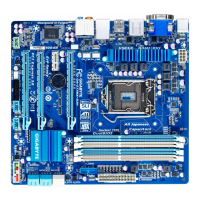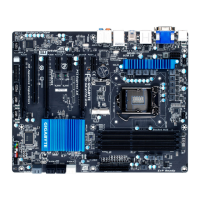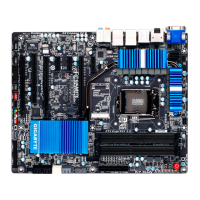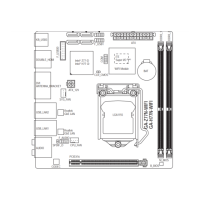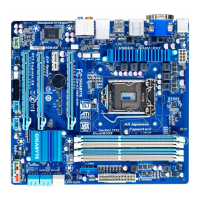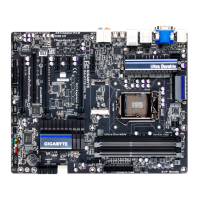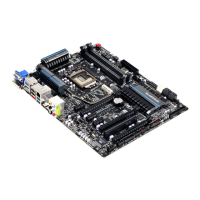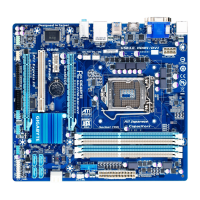Do you have a question about the Gigabyte GA-Z77-HD4 and is the answer not in the manual?
Essential safety and handling guidelines to prevent damage during installation.
Guidelines before installing the CPU to prevent damage and ensure correct placement.
Step-by-step instructions for correctly installing the CPU into the socket.
Detailed steps for opening the socket lever and aligning the CPU for insertion.
Instructions for securing the CPU and closing the socket lever after installation.
Step-by-step guide for mounting the CPU cooler securely onto the motherboard.
Guidelines before installing memory modules to prevent damage.
Detailed steps for inserting a memory module into the DIMM socket correctly.
Specific instructions for installing and removing a graphics card.
Introduction to BIOS functions and how to enter the setup utility.
Overview of GIGABYTE's Q-Flash and @BIOS utilities.
Options for adjusting CPU, PCIe, and memory frequencies.
Allows manual adjustment of the CPU base clock and PCIe bus frequency.
Settings for CPU clock multiplier and current operating frequency.
Adjustments for CPU core voltage, PLL overvoltage, and turbo ratios.
Settings for XMP profiles, system memory multiplier, and frequency.
Tuning memory performance via XMP, performance levels, and DRAM timing selection.
Detailed memory timing configurations for memory channels A and B.
Advanced options for controlling system voltages.
Controls for PWM phase and Vcore voltage response time.
Settings for Vcore loadline calibration and over-voltage protection.
Options for controlling CPU core and DRAM voltages.
Configuration options for CPU and system fan speed control.
Specifies the order in which devices are checked for booting.
Configures SATA controllers to IDE, RAID, or AHCI mode.
Options to save changes, exit, or exit without saving.
Options to load default settings and select a boot device.
Step-by-step guide for installing the motherboard chipset drivers.
Introduces GIGABYTE's BIOS update tools: Q-Flash and @BIOS.
Step-by-step guide for updating the BIOS using the Q-Flash utility.
Procedure for updating BIOS using a USB flash drive with Q-Flash.
Detailed steps for inserting the drive, selecting file, and completing the update.
Recommended step to load optimized defaults after a BIOS update.
Final steps to save changes and exit the BIOS setup.
Instructions for updating BIOS via internet or from a file.
Details on the functions of CPU, Memory, Tuner, Graphics, Smart, and HW Monitor tabs.
Steps to configure the system BIOS and drivers for RAID setup.
Instructions for using the X.H.D utility to set up RAID 0 arrays.
Guide for installing the EZ Setup application from the driver disk.
Steps to launch EZ Setup and select utilities for installation.
Step-by-step guide for installing and enabling EZ Smart Response.
Step-by-step guide for installing and enabling EZ Rapid Start.
Steps for installing, configuring, and enabling EZ Smart Connect.
Guide on configuring SATA hard drives, including RAID setup.
Steps for installing SATA hard drives and configuring controller mode.
Instructions for setting SATA controller mode (IDE, AHCI, RAID) in BIOS.
Steps to enter the RAID BIOS utility and create a RAID array.
Steps to name the RAID volume and choose the RAID level.
Instructions for selecting hard drives and setting the stripe block size.
Final steps to set array capacity and confirm volume creation.
Choose the master and recovery disks for the volume.
Guide for installing drivers in Windows 7 after OS installation.
Steps for installing SATA RAID/AHCI drivers during Windows XP setup.
Initiate driver installation during Windows XP setup by pressing F6.
Choose the correct controller and install the driver from the floppy disk.
Steps for setting up 2, 4, 5.1, or 7.1 channel audio configurations.
Answers to common questions regarding motherboard issues.
A step-by-step flowchart to diagnose and solve system startup problems.
| Form Factor | ATX |
|---|---|
| Socket | LGA 1155 |
| Chipset | Intel Z77 |
| Memory Type | DDR3 |
| Memory Slots | 4 |
| Max Memory Support | 32GB |
| PCIe 3.0 x16 Slots | 1 |
| PCIe 2.0 x16 Slots | 1 |
| PCIe x1 Slots | 2 |
| PCI Slots | 2 |
| SATA 6Gb/s Ports | 2 |
| SATA 3Gb/s Ports | 4 |
| USB 3.0 Ports | 4 |
| Memory Standard | DDR3 1600/1333/1066 MHz |
| LAN | Realtek GbE LAN |
| Audio | Realtek ALC887 |
| RAID Support | 0, 1, 5, 10 |
